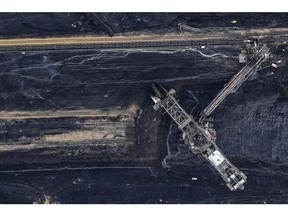Article content
(Bloomberg) — German coal mines spew 184 times more methane than what the country reports to the United Nations, according to a new analysis by Ember.
The energy think tank used methodology developed by scientists that takes into account the gas content of coal and mining depths to estimate the emissions, which cast fresh scrutiny on Germany’s strategy of pivoting towards fossil fuels in the wake of Japan’s 2011 Fukushima nuclear disaster.
Article content
Ember recommended Germany updates how it calculates the emissions, which it said is based on data from a 1989 study by a mining company.
“A wide-ranging measurement campaign would be the start to understanding the true scale of its methane emissions,” said Sabina Assan, the author of the report and a coal-mine methane analyst at Ember. “Developing a vigorous surface coal-mine methane measurement standard would put the country on track to be a true climate leader.”
Ember also used satellite observations in its analysis and said it identified methane emissions over multiple mines with the highest concentrations spotted over RWE AG’s Hambach and the Welzow-Süd reserves of Lausitz Energie Bergbau AG (LEAG). Germany’s economy ministry said in a statement that it will analyze the methodologies and results of the Ember study.
Researchers have used satellite data and updated methodologies to estimate methane emissions from other countries and compare them with officially reported numbers. Separate studies suggest that Indonesia, the third-biggest coal miner after China and India, undercounts emissions from the production of the fossil fuel by six to seven times, while Australia underreports methane from coal by 80%.
Article content
RWE said it follows the law and will implement any changes that are expected to come under the forthcoming EU Methane Regulation. Data in the study wasn’t categorized to show other potential sources of pollution and the research didn’t disclose potential variables that could have influenced the findings, LEAG, an entity of Czech EPH, said in a statement.
Germany estimates emissions from its lignite coal mines by multiplying each ton of production by 0.015 cubic meters of methane, according to Ember. The so-called emissions factor is based on a 1989 study by Rheinbraun AG, an RWE affiliate, and “substantiated by publications of the German Society for Petroleum and Coal Science and Technology,” according to last year’s public inventory report.
Lignite coal, also known as brown coal, is one of the lowest grades of the fuel with a relatively low concentration of carbon. Because Ember wasn’t able to find any data on the methane content of lignite from German mines, it used measurements from Polish lignite, which it said Germany considers comparable to its own.
Christian Böttcher, co-author of Germany’s annual national inventory report which is published by the Federal Environment Agency, said that while neighboring countries’ lignite are similar, a model used by Ember to estimate emissions comes from a study about US hard coal. Lignite is more porous and doesn’t trap methane like hard coal deposits, he said.
Article content
The nonprofit said it reached out to the German’s environment agency seeking the data which was used to calculate the emission factor that the nation currently uses and was told it wasn’t publicly available.
Böttcher said his agency — which only reports emissions data but cannot enforce reductions — did not have access to the original measurement data from 1989. “However, we have asked the successor operators and the association to send us the original data or to substantiate them with new measurements.”
Some coal-producing countries are updating how they calculate methane emissions from mining. In 2022, Australia revised its emissions factor for methane from open-cut coal mines, a change that meant total national annual emissions were on average 0.3% higher than stated over the last three decades.
If the Ember analysis is accurate, it would represent a 14% increase in national methane emissions for Germany, according to the report. An estimate by scientists using satellite data found emissions from the nation’s coal reserves were 79 times higher than reported and the International Energy Agency has estimated they are 28 times higher than reported, according to Ember.
Share this article in your social network

